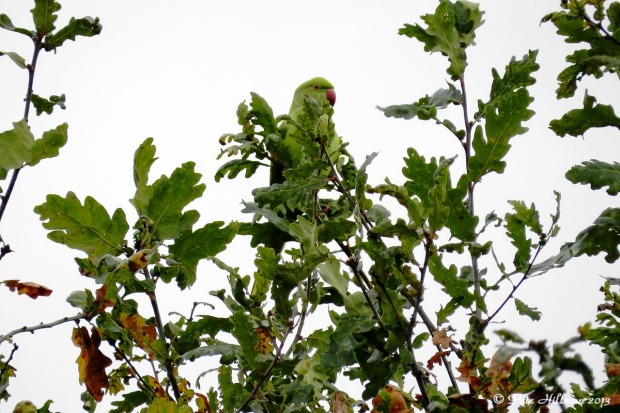Psittacula krameri
This was quite a long shot, and I was probably stretching the camera I had at the time to the max. However, I heard the squawk of this bird before I laid my eyes on it, and then I barely saw it for it was right at the top of an old oak tree some distance off, and its ground colour blended quite well with the foliage.
Also called the ‘Rose-ringed Parakeet’, these are the world’s most northerly breeding parrots. They became established in the UK in the 1970s after caged birds were released or escaped, and are now Britain’s most abundant naturalised parrots. As already mentioned, this bird draws attention straight away with its loud squawking call. It has bright green plumage with a long tail. It also has a short, bright red bill and red eye-ring. Males have a black chin and a dark neck-ring with a red nape. Females have a plain green head, as can just about seen above.
They eat seeds and fruit, and also attend garden bird feeders. They nest in tree holes and lay 3-6 eggs in up to 2 broods, beginning early in the season. They can live for up to 30 years.
Seen all year round. Mainly found in urban or suburban habitats, such as open woodland, parks and gardens. An introduced breeder, either deliberately let loose or an escapee. Originally from India. Established mainly in southern England, but spreading northwards.
Photograph of Ring-necked Parakeet (Psittacula krameri), taken November 2013, nature reserve, Staffordshire. © Pete Hillman 2013. Camera used Nikon Coolpix P500.

Beautiful bird, Pete.
LikeLiked by 1 person
Thank you, Jane 🙂 The males are supposed to be more colourful, but I have yet to spot one.
LikeLiked by 1 person
We have a wild colony (maybe more?) down here in Johannesburg. Occasionally one or two birds will fly over our property and I have managed a single, rather blurry photo!
At least I have the proof!
LikeLiked by 1 person
Thank you for your comment. It must be great to have these beautiful birds fly over you where you live. The last time I saw one of these parrots was when I took this photo.
LikeLiked by 1 person
Well, it might be if we ever got to really see them! It’s usually a case of hearing a raucous squawk, leg it outside in time to see something disappear over the horizon – hence the single blurry shot I managed!
I have been fairly lucky with photographing a number of others, but not this one.
LikeLiked by 1 person
Yes, I will never forget that loud squawk myself which drew my attention to it in the first place. All the best in hopefully getting a better photo of it one day yourself.
LikeLike
I am not holding out too much hope, but as I have managed to photograph over 30 different species to date that have paid us a visit I can’t complain!
LikeLiked by 1 person
That is really good going, well done! 🙂
LikeLike
It started as a quest simply to record all the fauna that visited our garden and only later did it develop into a more detailed photographic record.
We have recorded/sighted 47 species so far, including Great Eagle Owl, Grey Heron, Green Woodhoopoe, European Hoopoe, Hadeda Ibis.
LikeLiked by 1 person
It sounds like a fabulous quest. It is similar to how I started here, with recording what visted the garden, and then it kind of spread outwards to include, well virtually anywhere I visited in my spare time.
LikeLike
It is a good idea not only for personal satisfaction but also to track migratory and settlement patterns of various species.
I managed to photograph a Rameron Pigeon on two occasions and they are normally seen in warmer, sub tropical climes nearer Durban. (600 kms distant)
Apparently they have gradually migrated more inland as one of their food sources – a berry ( forget which one offhand) began to show up here.
And there are several organisations that one can enter this info onto their websites and they correlate all these stats.
For insects as well, and especially the distribution of butterflies.
LikeLiked by 1 person
Indeed, it can be a great aid to conservation bodies. Over here we have seen a declne in some of our once commonest birds, butterflies and bees, which is very sad. I just hope we all can learn from this before species really become thin on the ground and they won’t be around for future generations to enjoy.
LikeLiked by 1 person